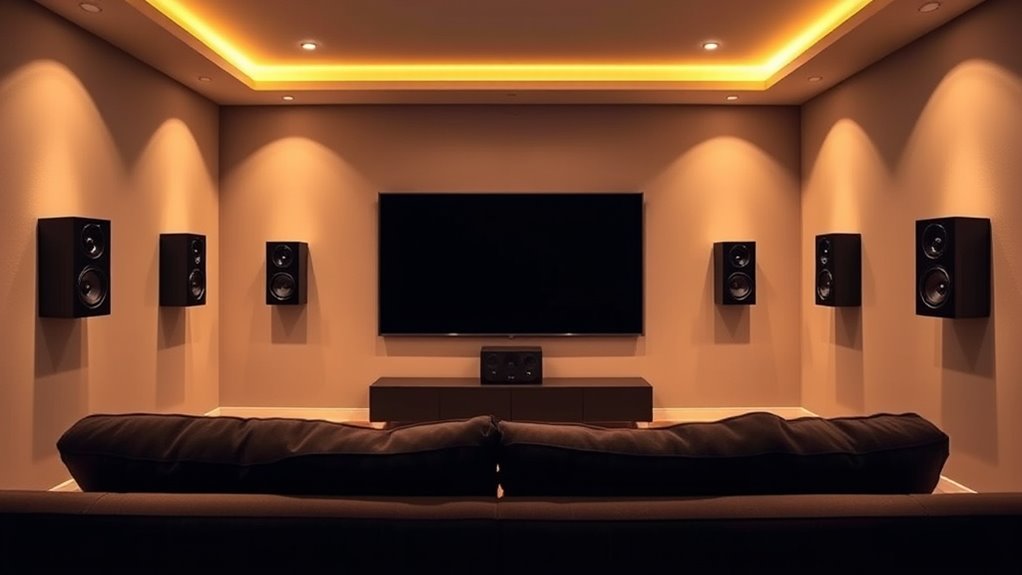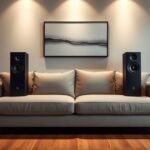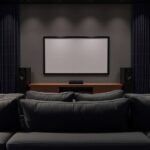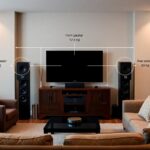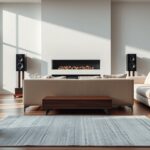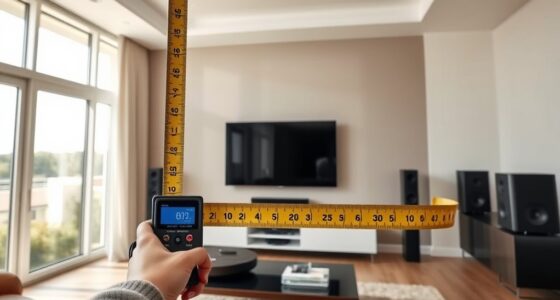To optimize your surround sound setup, position your speakers at ear level and form an equilateral triangle with your main listening spot. Slightly tilt (toe-in) your speakers toward you, avoiding placement too close to walls to prevent bass boom. Use soft furnishings to absorb echoes and ensure unobstructed sound paths. Proper arrangement boosts clarity, imaging, and immersion. Keep experimenting with placement and angles to achieve the best sound. If you continue exploring, you’ll discover more tips to perfect your layout.
Key Takeaways
- Form an equilateral triangle with speakers and your main listening position for balanced surround sound.
- Aim tweeters at ear level and slightly toe-in for clearer high frequencies and better imaging.
- Position surround speakers slightly behind and beside seating, angled toward the listener for immersive effects.
- Use room furnishings like rugs and curtains to absorb reflections and reduce echo for cleaner audio.
- Keep large objects away from direct sound paths to prevent interference and optimize sound clarity.
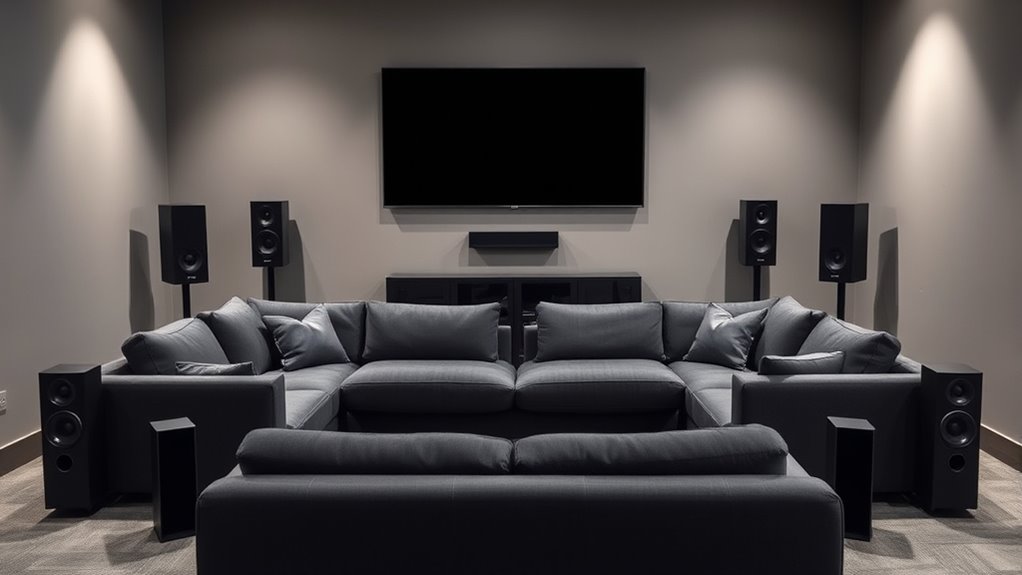
Have you ever wondered how to get the best sound from your speakers? The key lies in proper placement. When your speakers are positioned correctly, you’ll notice a significant improvement in clarity, balance, and overall audio quality. It’s not just about the quality of the speakers themselves—where you put them makes all the difference. First, consider the layout of your room. Find a central spot where your main listening position will be, and aim to set your speakers at ear level when you’re seated. This guarantees that sound travels directly to you without unnecessary distortion or echo. Avoid placing speakers too high or low, as that can cause uneven sound distribution and make some frequencies harder to hear.
Proper speaker placement at ear level ensures clear, balanced sound for an immersive listening experience.
Next, think about the distance between your speakers. Ideally, they should form an equilateral triangle with your listening position. If your speakers are too close together or too far apart, you’ll experience a loss of stereo imaging and soundstage. A good rule of thumb is to keep the distance between speakers roughly the same as the distance from each speaker to your seat. This setup helps create a balanced, immersive sound environment. Keep in mind that symmetry matters—try to position your speakers so they’re equidistant from walls or corners, which can cause reflections and muddle the sound. If you have to place them near walls, pull them slightly away to reduce bass boom and reflections.
The angle of your speakers is just as important as their placement. Aim the tweeters—the high-frequency drivers—directly at your ears for maximum clarity. This slight toe-in can make a noticeable difference in sound precision. Avoid pointing your speakers straight at a wall or corner, as this can cause sound reflections that muddy the audio. Additionally, consider the room’s acoustics. Soft furnishings, rugs, and curtains can absorb excess sound reflections, while hard surfaces may cause echoes. room acoustics play a crucial role in sound quality and should be optimized when possible. Using measurement tools can help you analyze your space and fine-tune your setup for superior sound. Remember that creative practice includes experimenting with different arrangements until you find the optimal setup for your space.
Finally, don’t forget about the influence of furniture and other objects in your space. Keep large objects away from the direct path of sound waves to prevent unwanted interference. If you’re using a surround sound system, position the rear speakers slightly behind your seating area, angled toward the listening position, to envelop you in sound. Proper speaker placement not only improves audio clarity but also enhances the immersive experience, making your listening session more enjoyable. By paying attention to these placement principles, you’ll unlock the full potential of your speakers and enjoy a rich, immersive audio experience every time.
Frequently Asked Questions
How Does Room Shape Affect Speaker Placement?
Room shape considerably impacts your speaker placement because irregular or oddly shaped rooms can cause sound reflections and dead spots. If your room has alcoves, angles, or uneven walls, you’ll need to adjust speaker positions to minimize echo and optimize sound clarity. A rectangular or square room generally makes placement easier, allowing you to create a balanced soundstage. Always test and tweak your setup to ensure the best surround sound experience.
What Is the Ideal Distance Between Speakers?
Think of speaker placement like setting a balanced team for a game. The ideal distance between speakers is generally about equal to the distance from your listening position to each speaker, forming an equilateral triangle. This usually means placing them 6 to 10 feet apart, depending on your room size. Keep them slightly in front of you, angling toward your ears, to create a clear and immersive soundstage.
How Do I Calibrate My Surround Sound System?
To calibrate your surround sound system, start by connecting your calibration microphone and accessing your receiver’s setup menu. Follow the on-screen prompts or use an auto-calibration feature if available. Play the calibration tone, and the system will automatically adjust the speaker levels, distances, and crossover settings for ideal sound. Make manual tweaks if necessary, ensuring sound is balanced and immersive from your listening position.
Can Furniture Placement Impact Sound Quality?
Imagine you’re in a vintage radio show, and furniture placement can totally impact your sound experience. Yes, your furniture influences sound quality by absorbing, reflecting, or diffusing audio. Large pieces can block or bounce sound waves, muddying clarity. To optimize sound, position furniture thoughtfully, avoiding obstructions near speakers, and consider using soft furnishings to absorb excess echoes. This way, your surround sound system delivers a richer, more immersive experience.
What Are Common Mistakes to Avoid in Speaker Setup?
When setting up your speakers, avoid common mistakes like placing them too close to walls or corners, which can cause unwanted bass boost and muddiness. Don’t overlook proper height and angling; speakers should be at ear level and aimed toward your listening position. Also, steer clear of uneven spacing or placing speakers too far apart, as this can weaken sound imaging. Taking these steps guarantees a clear, balanced surround sound experience.
Conclusion
By now, you’re equipped to craft a surround sound setup that immerses like a symphony. Remember, speaker placement isn’t just about positioning; it’s about creating a sonic landscape where every note finds its home. Think of your room as a canvas, and your speakers as the brushstrokes—carefully placed to paint a vivid auditory masterpiece. With a little patience and precision, you’ll transform your space into a personal concert hall.
